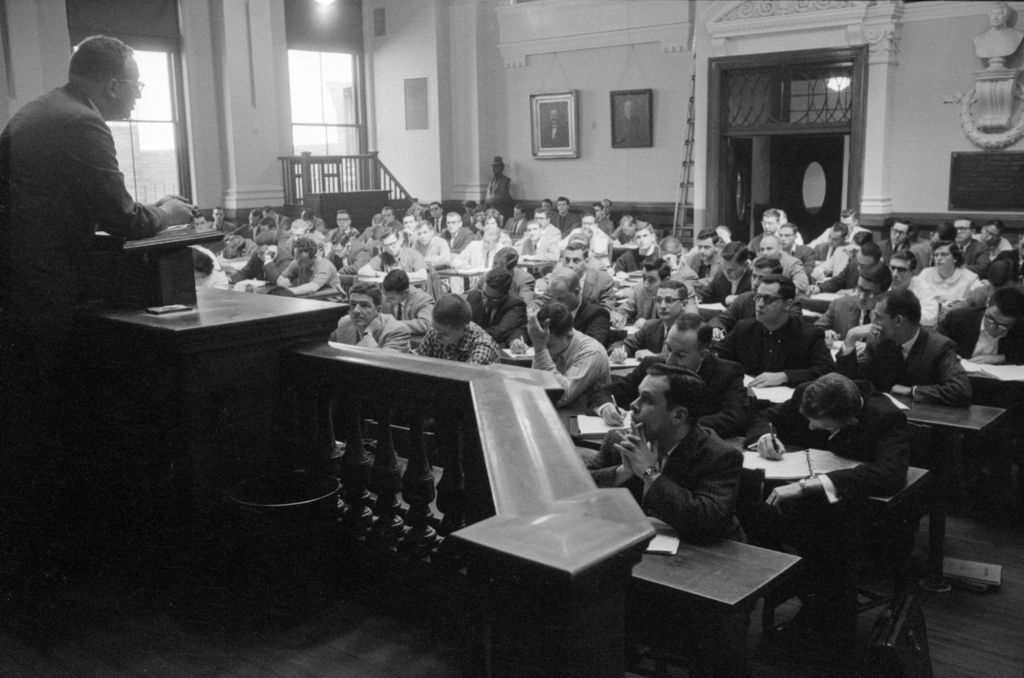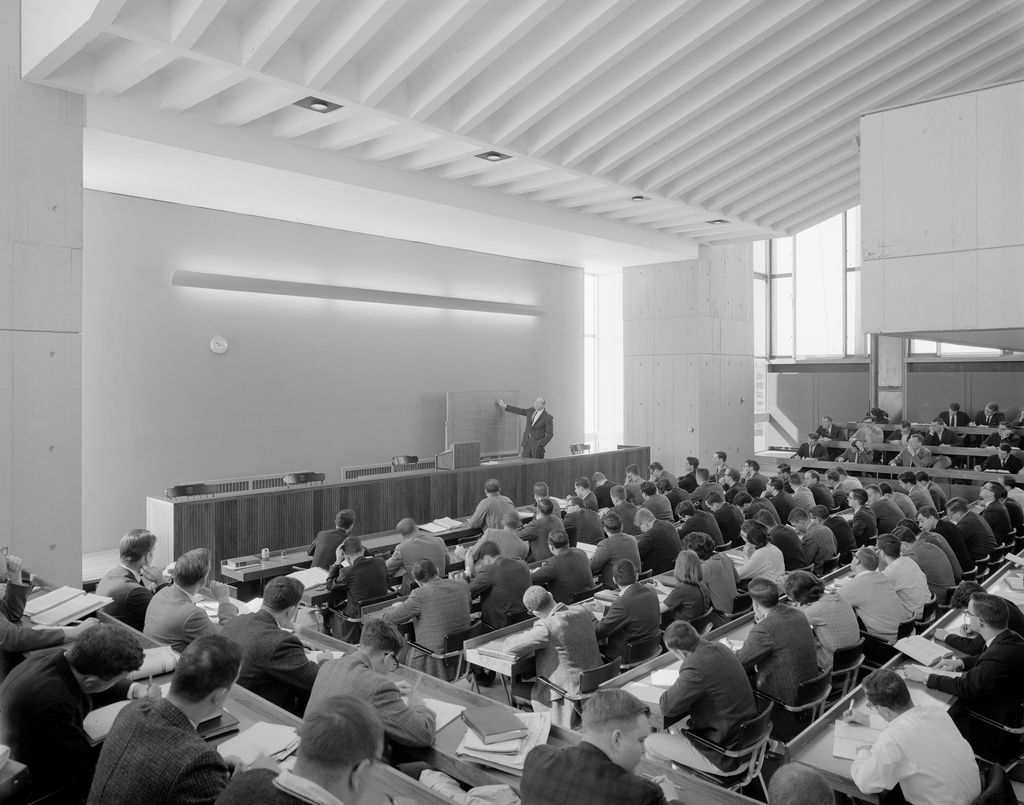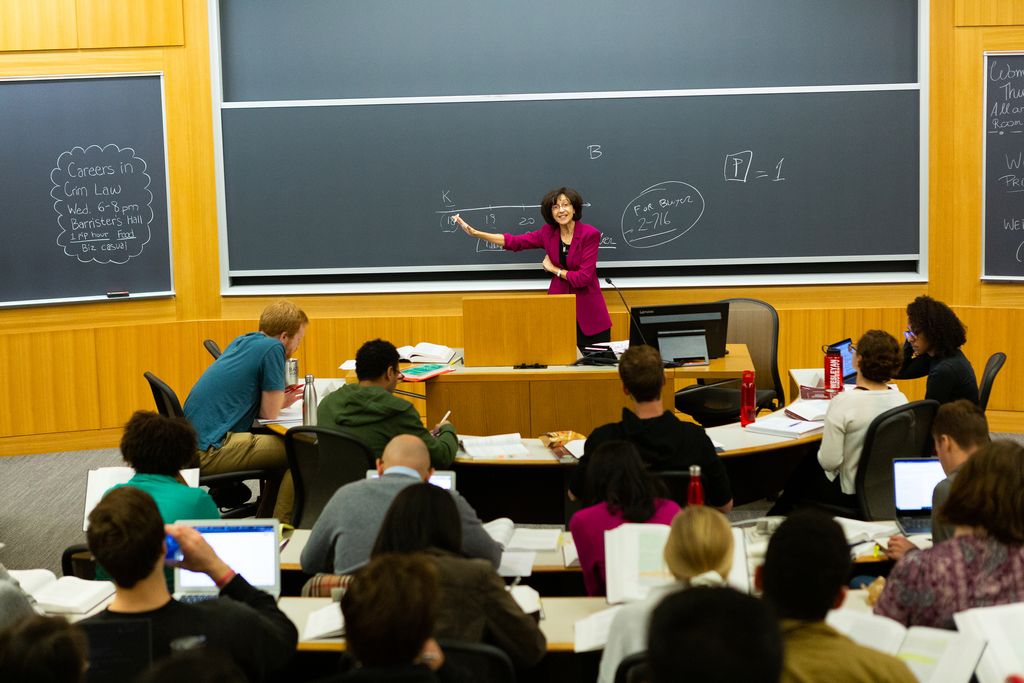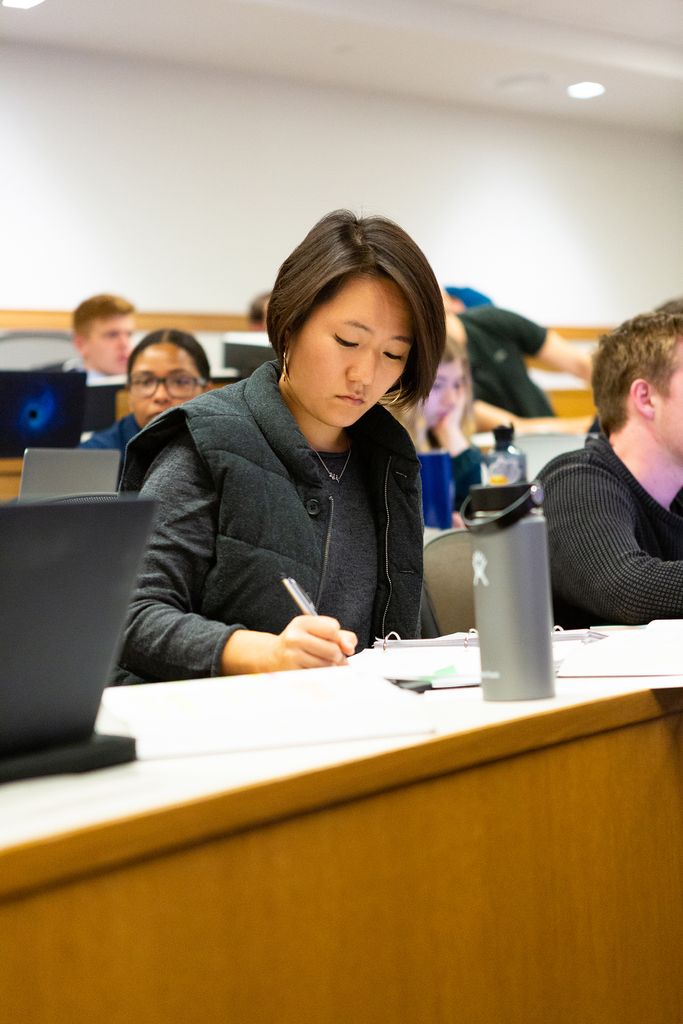Models for Modern Law
Since its founding, BU Law has helped drive change among law schools and in the field of legal education.

In 1829, when admission to the bar required little more than reading the books of practicing attorneys and shadowing them in their work, a university president in Tennessee declared in a speech that it was easier to become a lawyer in that state than it was to shoe a horse.
Decades later in Massachusetts, the path may have been even less onerous. An 1870 article in the American Law Review said that Harvard Law School—the only law school in the commonwealth at the time and one of only about 30 in the country—had been “almost a disgrace.” Like most law schools at the time, it did not require entrance or final exams or any amount of undergraduate study. If students attended lectures and paid their fees, they graduated.
“A school which undertook to confer degrees without any preliminary examination whatever was doing something every year to injure the profession throughout the country,” stated the unsigned article, most likely written by Oliver Wendell Holmes Jr. “So long as the possession of a degree signified nothing except a residence for a certain period in Cambridge or Boston, it was without value.”
But legal education was about to change in Massachusetts—and across the United States. Some of those changes came from Harvard, where the course of study soon became more rigorous and where, in 1871, Dean C.C. Langdell introduced the case method still used in classrooms today.
Other changes, however, were driven in part by a new law school that launched across the Charles River. Boston University was chartered in 1869 and the law school opened its doors in the fall of 1872, helping usher in a new era in legal education. BU School of Law—or the Boston Law School, as it was known at the time—immediately raised the bar for entrance into the legal profession. It was the first law school in the country to propose a three-year curriculum, encourage a bachelor’s degree for admission, and require exams at the end of every course. And even the exams were ahead of their time. In 1877, a criminal law question asked:
“What crime, if any, is it in a mother, in abject poverty, to drown her children, to save them from want and suffering, to which she is sure they will be exposed, if allowed to grow up?”
“They were remarkably modern,” says BU Law Professor David J. Seipp, a legal historian and BU Law’s unofficial recordkeeper, of the exams. “They look like questions we ask today—issue spotter questions. The old style had memorization-type questions typical of the state bar exam at the time. These new questions were about thinking like a lawyer, on the spot, under pressure.”
Of course, legal education has continued to evolve—the ABA has taken steps to make entrance exams optional, for instance—and BU Law has kept pace. Over its 150-year history, the law school has been a leader and an innovator, anticipating and responding to changes in the profession and world by enhancing its experiential learning opportunities; strengthening its ties to other professions, including medicine and finance; and engaging with society’s systemic problems in its curriculum and in practice. In its early years, BU Law’s educational motto was to teach students “what to do and how to do it,” and, over the decades, it has generally been open-minded about how to achieve those ends.
Meeting the Moment
Since its founding, BU Law has identified and attempted to bridge gaps between the legal profession and broader society. For example, around the time of President Franklin D. Roosevelt’s New Deal reforms, the law school began offering courses on administrative law to help acclimate students to the “increasing number of administrative boards and commissions” in the country, according to a 1960 history of the law school.

“In the early 20th century, administrative law wasn’t really a subject,” says Philip S. Beck Professor of Law Jack M. Beermann, who has written several books on the topic. “Then, when Congress started forming new government agencies in the New Deal period in the 1930s, it exploded. At that point, it was impossible to ignore administrative law as a separate subject.”
In 1958, BU Law turned its attention to another matter of national importance: health. With a grant from the National Institutes of Health, it launched the Law-Medicine Research Institute, the first entity of its kind to engage in interdisciplinary training in law, medicine, public health, and the behavioral sciences. In its first few years, the institute explored the legal and ethical ramifications of using human subjects in clinical trials and conducted a study for the Massachusetts Department of Public Health that eventually led to the development of the commonwealth’s public health code. Over time, the institute evolved into what is now the Center of Health Law, Bioethics & Human Rights at the School of Public Health, which works in partnership with the law school’s well-regarded health law program.
The following year, BU Law established the Graduate Tax Program, one of the nation’s first. Future Massachusetts Supreme Judicial Court Justice Paul J. Liacos (LAW’52, Hon.’96) taught one of the initial two courses in the program, which was created to help prepare lawyers for the increasingly complex field of tax law. Today, the program is consistently top-ranked and offers classes in the late afternoons and evenings to accommodate the schedules of working professionals.
In 1978, BU Law again blazed a trail, launching the Morin Center for Banking & Financial Law to train lawyers for leadership positions in both domestic and international banking and financial services industries. In the 1980s, the center developed into the Graduate Program in Banking & Financial Law. Now the oldest LLM degree of its kind in the United States, it remains highly relevant and offers concentrations in the business of banking, compliance management, financial services transactions, lending and credit transactions, and securities transactions.
Practical Experience
From the start of classroom legal education, professors and practitioners have debated the best way to balance theory and practice. According to a 2018 Dickinson Law Review article, although it considered the issue for years, the ABA didn’t require any form of experiential learning until 2005, when it mandated “substantial instruction” in “professional skills.” In 2014, the ABA adopted the current standard of six credits of experiential learning in the form of simulations, clinics, or field placements.
Some law students acted much sooner, creating volunteer legal aid bureaus as early as the 1890s. But the move toward “clinical” legal education more broadly really picked up steam in the 1950s and 1960s, according to a 2009 Clinical Law Review article.
The Ford Foundation had provided early seed money in this effort, and Boston University School of Law was a recipient. In 1962, BU Law had started a pilot program called the Voluntary Defenders in which 30 third-year students spent weekdays at the Roxbury District Courthouse representing criminal defendants under the supervision of a full-time clinical professor. The Ford Foundation provided a grant to the program in 1964, and it has been in operation ever since, along with a prosecutorial clinic that was first funded by the US Department of Justice in 1967 (both programs are now fully supported by the law school and are part of the Criminal Law Clinical Program).

Dean Elwood Harrison Hettrick (’38) teaches a class in 1958.

Professor William Schwartz (’55), who later served as dean, leads the first class taught at the BU Law tower in 1964.
Left: Dean Elwood Harrison Hettrick (’38) teaches a class in 1958.
Right: Professor William Schwartz (’55), who later served as dean, leads the first class taught at the BU Law tower in 1964.
Photos courtesy of BU Photo
Professor David Rossman, who started as an instructor in the Defender Clinic before becoming director of the Criminal Law Clinical Program in 1978, says the clinics were created in response to student demand.
“A large component was students’ social consciousness in the 1960s and their attitudes toward what they saw as the social responsibility of lawyers,” he says. “But they also wanted an experience other than the Socratic method that was predominant at the time.”
Since the formation of those first two clinics, BU Law’s experiential learning opportunities have expanded exponentially. When Clinical Professor Peggy Maisel (’75) was a student at BU Law in the early 1970s, clinical spots were awarded in a lottery. She didn’t get into either of the criminal law clinics or their civil counterpart, which began in 1969 and in which students worked on cases with the Boston Legal Assistance Project (now Greater Boston Legal Services).
“I very much wanted to, but the number of students accepted into clinics was miniscule,” she recalls.
Today, BU Law guarantees JD students at least one clinical experience in their second or third year and many students do more. And there are 11 clinics from which to choose, on issues ranging from immigrants’ and employment rights to legislative drafting and civil litigation. There are also dozens of externships, semester-in-practice placements, and practicums.
Maisel increased hands-on learning opportunities at BU Law when she was hired in 2014 as the first associate dean for experiential education. She helped develop the Startup Law and Technology Law clinics, in which BU Law students advise BU and MIT students on their entrepreneurial activities, and the Compliance Policy Clinic, which launched in 2020 to provide students the opportunity to advise private-sector, public-sector, and NGO partners and clients on ethics and compliance issues.
First-Year Foundation
Some of BU Law’s most recent innovations have come in the first-year curriculum. Maisel was part of one overhaul in 2014, when the school began to build out what is now the Lawyering Program and implemented the Lawyering Lab, an intensive transactional simulation that takes place between the fall and spring semesters.
More recently, the faculty has committed to a more systemic overhaul of its required classes. In 2020, BU Law hosted a two-day symposium on bias in the 1L curriculum. Panelists included faculty members from law schools across the country and BU Law students, who spoke about what they had encountered in the classroom.
“Students found certain aspects of the 1L curriculum oppressive and disconnected from their realities now and from the problems they expected to address in the future,” says Dean Angela Onwuachi-Willig, who opened the symposium with remarks about her own experiences as a student of color. “Our students challenged the notion of legal doctrine as being purely neutral and objective. They understood neutrality and objectivity to be the goals, but the doctrine itself reflected the limited realities of the judges who wrote the case law. Concepts like the ‘reasonable person standard’ had raced, gendered, classed, heteronormative, and other lenses to them.”

Professor Daniela Caruso gestures to the blackboard at the front of a classroom in the Sumner M. Redstone building at BU Law.

A student takes notes in a classroom in the Redstone building in 2019.
Left: Professor Daniela Caruso gestures to the blackboard at the front of a classroom in the Sumner M. Redstone building at BU Law.
Right: A student takes notes in a classroom in the Redstone building in 2019.
Photos by Michael Spencer
Since then, individual faculty members have made a conscious effort to include conversations about race and inequality in their classes. But Onwuachi-Willig has also sought to empower students to initiate those discussions and debates themselves, in part by introducing these complex topics and ideas during orientation at the beginning of the year.
“We want students to know we believe their voices and insights are important. They have much to teach us, too. They need to be thinking critically about legal doctrine and asking questions about the assumptions underlying the doctrine,” she says.
Onwuachi-Willig, who in 2021 was named the inaugural Ryan Roth Gallo and Ernest J. Gallo Professor—the first chair devoted to critical race theory in the country—has long been a leader in efforts to make the legal academy and legal profession more diverse. In 2020, she helped organize more than 170 law school deans in a successful campaign to push the ABA to require antibias training for students.
“We were already working, incorporating more inclusive pedagogies in all our classes,” Onwuachi-Willig says. “We’re now working on a possible new first-year, one-credit course that meets the ABA requirement precisely because we believe, as the ABA and many deans do, that all lawyers need such training to be effective practitioners.”
Embracing the Future
Current Associate Dean of Clinical & Experiential Education Karen Pita Loor says faculty members also have been revamping their syllabi in response to trainings they have received on issues of bias.
“We are really leading in this area,” Loor says. “Students want to have these conversations. People want to think about the law in a different way.”
Maisel credits the faculty with embracing and welcoming many of the changes, some of which were initiated in response to alumni feedback.
“The faculty really listened,” she says. “That was very productive.”
In fact, BU Law has always sought out faculty who are attuned to the needs of their students and the profession. In 1969, describing the fledgling clinical law program, BU Law Assistant Dean John P. Wilson wrote that “those attempting to create and shape programs which are responsive to a changing society and the possible need for new teaching techniques must usually do so in the hurly-burly of other activities and demands.” He compared the process to “attempting to build a raft after one has cast off from the bank and is being buffeted in mid-stream.”
Beermann says BU Law professors are up for the challenge.
“We are a risk-taking, trailblazing, innovative faculty,” he says. “It’s been really remarkable to see how flexible the more traditional classroom faculty have been to adapting what we do in the law school to the current reality. That’s a real strength.”

FEATURED IN
